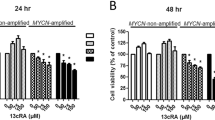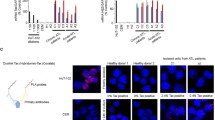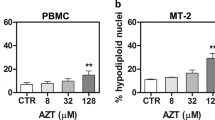Abstract
We previously reported that all-trans retinoic acid (ATRA) inhibits growth in human T-cell leukemia virus type 1 (HTLV-1)-positive T-cell lines and fresh cells from patients with adult T-cell leukemia. However, the mechanism of this inhibition is not clear. In the present study, we observed that NF-κB transcriptional activity as well as cell growth decreased significantly in HTLV-1-positive T-cell lines in the presence of ATRA. Furthermore, we observed that ATRA reduced HTLV-1 proviral DNA, HTLV-1 genes (gag, tax, or pol mRNA) using the real-time quantitative polymerase chain reaction. SIL-2R was reduced by ATRA in both protein level (culture supernantant) and mRNA level in HTLV-1-positive T-cell lines. Interestingly, ATRA significantly inhibited RT activity similar to azidothimidine (AZT) in HTLV-1-positive T-cell lines. Moreover, AZT inhibited proviral DNA but not NF-κB transcriptional activity, and sIL-2R on HTLV-1; however, ATRA inhibited of NF-κB, proviral DNA and sIL-2R on HTLV-1. These results suggested that the decrease in sIL-2R induced by ATRA may be caused by the actions of a NF-κB inhibitor acting on the NF-κB/sIL-2R signal pathway. These results suggested that ATRA could have two roles, as a NF-κB inhibitor and as an RT inhibitor.
This is a preview of subscription content, access via your institution
Access options
Subscribe to this journal
Receive 12 print issues and online access
$259.00 per year
only $21.58 per issue
Buy this article
- Purchase on Springer Link
- Instant access to full article PDF
Prices may be subject to local taxes which are calculated during checkout




Similar content being viewed by others
References
Hinuma Y, Komoda H, Chosa T, Kondo T, Kohakura M, Takenaka T et al. Antibodies to adult T-cell leukemia-virus-associated antigen (ATLA) in sera from patients with ATL and controls in Japan; a nation-wide sero epidemiologic study. Int J Cancer 1982; 29: 631–635.
Kaplan JE, Khabbaz RF . The epideminology of human T-lymphotropic virus types I and II. Med Virol 1993; 3: 137–148.
Gessain A . Epidemiology of HTLV-I and associated diseases. In: Hollsberg P Uafler DA (eds). Human T-Cell Lymphotropic Virus Type 2. New York: John Wiley Sons Ltd, 1996, pp 633–664.
Franchini G . Molecular mechanisms of human T-cell leukemia/lymphotropicvirus type 1 infection. Blood 1995; 86: 3619–3639.
Shimoyama and members of the Lymphoma study group. Diagnostic criteria and classification of clinical subtypes of adult T-cell leukemia-lymphoma. Br J Hematol 1991; 79: 428–437.
Shimoyama M . Treatment of patients with adult T-cell leukemia-lymphoma: an overview. In: Takatsuki K, Hinuma Y, Yoshida M (eds). Advances in Adult T-Cell Leukemia and HTLV-I Research, Vol. 39. Tokyo, Japan: Scientific Societies Press, 1992, pp 43–56.
Hermine O, Wattel E, Gessain A, Bazarbachi A . Adult T-cell leukemia: a review of established and new treatments. Bio Drugs 1998; 10: 447–462.
Bozarbachi A, Hermine O . Treatment of adult T cell leukemia/lymphoma: current strategy and future perspectives. Virus Res 2001; 78: 79–92.
Taguchi H, Kinoshita KI, Takatsuki K, Tomonaga M, Araki K, Arima N et al. An intensive chemotherapy of adult T-cell leukemia/lymphoma: CHOP followed by etoposide, vindesine, ranimustine, and mitoxantrone with granulocyte colony-stimulating factor support. J Acd Immun Defic Synd Hum Retrovirol 1996; 12: 182–189.
Borg A, Yin JA, Johnson PR, Tosswill Saunders M, Morris D . Successful treatment of HTLV-I-associated acute adult T-cell leukemia lymphoma by allogeneic bone marrow transplantation. Br J Haematol 1996; 94: 713–715.
Ljungman P, Lawler M, Asjo B, Bogdanovic G, Karlsson K, Malm C et al. Infection of donor lymphocytes with human T-lymphotrophic virus type I (HTLV-I) following allogeneic bone marrow transplantation for HTLV-2 positive adult T-cell leukaemia. Br J Haematol 1994; 88: 403–405.
Sobue R, Yamauchim T, Miyamura K, Sao H, Tahara T, Yoshikawa H et al. Treatment of adult T cell leukemia with mega-dose cyclophosphamide and total body irradiation followed by allogeneic bone marrow transplantation. Bone Marrow Transplant 1987; 2: 441–444.
Rio B, Louvet C, Gessain A, Dormont D, Gisselbrecht C, Matoia R et al. Adult T-cell leukemia and non-malignant adenopathies associated with HTLV-2 virus. Apropos of 17 patients born in the Caribbean region and Africa. Press Med 1990; 19: 746–751.
Lotan R . Effects of vitamin A and its analogs (retinoids) on normal and neoplastic cells. Biochem Biophys Acta 1980; 605: 33–91.
Smith MA, Parkinson DR, Cheson BD, Friedman MA . Retinoids in cancer therapy. J Clin Oncol 1992; 10: 839–864.
Tolbler A, Dawsaon M, Koeffler HP . Retinoid. Structure–function relationship in normal and leukemic hematopoiesis in vitro. J Clin Invest 1986; 78: 303–309.
Breitman TR, Selonick SE, Collins SJ . Induction of differentiation of the human promyelocytic leukemia cell line (HL-60) by retinoic acid. Proc Natl Acad Sci USA 1980; 77: 2936–2940.
Koeffler HP . Induction of differentiation of human acute myelogenous leukemia cells: therapeutic implications. Blood 1983; 62: 709–721.
Lotan R . Different susceptibilities of human melanoma and breast carcinoma cell lines to retinoic acid-induced growth inhibition. Cancer Res 1979; 39: 1014–1019.
Marth C, Daxenbichler G, Dapunt O . Synergistic antiproliferative effect of human recombinant interferons and retinoic acid in cultured breast cancer cells. J Natl Cancer Inst 1986; 77: 1197–1202.
Jetten AM, Kim JS, Sacks PG, Rearick JI, Lotan D, Hong WK et al. Inhibition of growth and squamous cell differentiation markers in cultured human head and neck squamous carcinoma cells by β-all-trans retinoic acid. Int J Cancer 1990; 45: 195–202.
Maeda Y, Miyatake J-I, Sono H, Matsuda M, Tatsumi Y, Horiuchi F et al. 13-cis retinoic acid inhibits growth of adult T-cell leukemia cells and causes apoptosis: possible new indicater for retinoid therapy. Inter Med 1996; 35: 180–184.
Maeda Y, Miyatake J-I, Sono H, Sumimoto Y, Matsuda M, Irimajiri K et al. New therapeutic affects of retinoid for adult T-cell leukemia. Blood 1996; 88: 4726–4727.
Miyatake J-I, Maeda Y . Inhibition of proliferation and CD25 down-regulation by retinoic acid in human adult T-cell leukemia cells. Leukemia 1997; 11: 401–407.
Miyatake J, Maeda Y, Sumimoto Y, Somo H, Horiuchi F, Tatsumi Y et al. Thiol compounds rescue growth inhibition by retinoic acid on HTLV-I (+) T lymphocytes; possible mechnism of retinoic acid induced growth inhibition of adult T cell leukemia. Hematopathol Mol Hematol 1998; 11: 89–99.
Tanaka A, Takahashi C, Yamaoka S, Nosaka T, Maki M, Hatanaka M . Oncogenic transformation by the tax gene of human T-cell leukemia virus type 2in vitro. Proc Natl Acad Sci USA 1990; 87: 1071–1075.
Feuer G, Chen IS . Mechanism of human T-cell leukemia virus-induced leukemogenesis. Biochim Biophys Acta 1992; 1114: 223–233.
Zhao LJ, Giam CZ . Interaction of human T-cell lymphotropic virus type 2 (HTLV-2) transcriptional activator Tax with cellular factors that bind specifically to the 21-base pair repeats in the HTLV-2 enhancer. Proc Natl Acad Sci USA 1991; 88: 11445–11449.
Kwoak RP, Lauranca ME, Lundblad JR, Goldman PS, Shih H, Conor LM et al. Control of camp-regulated enhancers by the viral transcription Tax through CREB and co-activator CBP. Nature 1996; 380: 642–646.
Hirai H, Suzuki T, Fujisawa J, Inoue J, Yoshida M . Tax protein of human T cell leukemia virus type 2 binds to the ankyrin motifs inhibitory factor κB and induces nuclear translocation of transcription factor NF-κB proteins for transcriptional activation. Proc Natl Acad Sci USA 1994; 91: 584–588.
Baeuerle PA . The inducible transcription activator NF-κB: regulation by distinct protein subunits. Biochim Biophys Acta 1991; 1072: 63–80.
Barinaga M . Life-death balance within the cell. Science 1996; 274: 724.
Mori N, Fujii M, Yamada Y, Tomonaga M, Ballard DW, Yamamoto N . Constitutive activation of NF-κB in primary adult T-cell leukemia cells. Blood 1999; 93: 2360–2368.
Nawata H, Maeda Y, Sumimoto Y, Miyatake J, Kanamaru A . A mechanism of apoptosis induced by all-trans retinoic acid on adult T-cell leukemia cells: a possible involvement of the Tax/NF-κB signaling pathway. Leuk Res 2001; 25: 323–331.
Tipping AJ, Mahon FX, Lagarde V, Goldman JM, Melo JV . Restoration of sensitivity to STI571 in STI-resistant chronic myeloid leukemia cells. Blood 2001; 98: 3864–3867.
Laurendeau I, Bahuau M, Vodovar N, Larramendy C, Olivi M, Bieche I et al. TaqMan PCR-based gene dosage assay for predictive testing in individuals from cancer family with INK4 locus haploinsufficiency. Clin Chem 1999; 45: 982–986.
Odawara F, Abe H, Kohno T, Nagai-Fujii Y, Arai K, Imamura S et al. A highly sensitive chemiluminescent reverse transcriptase assay for human immunodeficiency virus. J Virol Methods 2002; 106: 115–124.
Okamoto T, Wong-Staal F . Demonstration of virus specific transcriptional activator(s) in cells infective with HTLV-3 by an in vitro cell-free system. Cell 1986; 47: 29–35.
Okamoto T, Thomas B, Steven FJM, Reza S, Wong-Staal F . Transcriptional activation from the long-terminal repeat of human immunodeficiency virus in vitro. Virology 1990; 177: 606–614.
Okamoto T, Akagi T, Shima H, Miwa M, Shimotohno K . Superinduction of trans-activation accounts for augmented human immunodeficiency virus replication in HTLV-1-transformed cells. Jpn J Cancer Res 1987; 78: 1297–1301.
Arya SK, Guo C, Josephs SF, Wong-Staal F . Transactivator gene of human T-lymphotropic virus type 3 (HTLV-3). Science 1985; 229: 69–79.
Suzuki N, Matsunami N, Kanamori H, Ishida N, Shimizu A, Yaoita Y et al. The human IL-2 receptor gene contains a positive regulatory element that functions in cultured cells and cell-free extracts. J Biol Chem 1987; 262: 5079–5086.
Keedwell RG, Zhao Y, Hammond LA, Qin S, Tsang K-Y, Retmair A et al. A retinoid-related molecule that dose not bind to classical retinoid receptors potently induces apoptosis in human prostate cancer cells through rapid caspase activation. Cancer Res 2004; 64: 3302–3312.
Yodoi J, Uchiyama T . IL-2 receptor dysfunction and adult T cell leukemia. Immunol Rev 1986; 92: 135–156.
Suzuki T, Fujisawa J, Toita M, Yoshida M . The trans-activator Tax of human T-cell leukemia virus type 2 (HTLV-2) interacts with camp-responsive element (CRE) binding and CRE modulator proteins that bind to the 21-base-pair enhancer of HTLV-2. Proc Natl Acad Sci USA 1993; 90: 610–614.
Siekevitz M, Freinberg MB, Holbrook N, Wong-Staal F, Greene WC . Activation of interleukin 2 receptor (Tac) promoter expression by the transactivator (tat) gene product of human T-cell leukemia virus, type I. Proc Natl Acad Sci USA 1987; 84: 5389–5393.
Doi T, Hatakeyama M, Itoh S, Taniguchi T . Transient induction of IL-2 receptor in cultured T cell lines by HTLV-I LTR-linked Tax 1 gene. EMBO J 1989; 8: 1953–1958.
Leung K, Nabel GJ . HTLV-I transactivator induces interleukin 2 receptor expression through an NF-κB-like factor. Nature 1988; 333: 776–778.
Ballard DW, Bohnlein E, Lowenthal JW, Wano Y, Franza RB, Greene WC . HTLV-1 tax induces cellular proteins that activate the κB element in IL-2 receptor α gene. Science 1988; 241: 1652–1655.
Yodoi J, Uchiyama T . Diseases associated with HTLV-I virus, IL-2 receptor dysregulation and redox regulation. Immunol Today 1992; 13: 405–411.
Kamimura S, Atogami S, Sohda H, Momita S, Yamada Y, Tomonaga M . Significance of soluble interleukin-2 receptor levels for evaluation of the progression of adult T-cell leukemia. Cancer 1994; 73: 2753–2758.
Author information
Authors and Affiliations
Corresponding author
Rights and permissions
About this article
Cite this article
Yamaguchi, T., Maeda, Y., Ueda, S. et al. Dichotomy of all-trans retinoic acid inducing signals for adult T-cell leukemia. Leukemia 19, 1010–1017 (2005). https://doi.org/10.1038/sj.leu.2403760
Received:
Accepted:
Published:
Issue Date:
DOI: https://doi.org/10.1038/sj.leu.2403760
Keywords
This article is cited by
-
Clinical efficacy of all-trans retinoic acid for treating adult T cell leukemia
Journal of Cancer Research and Clinical Oncology (2008)



